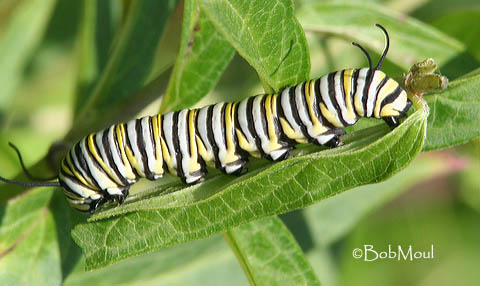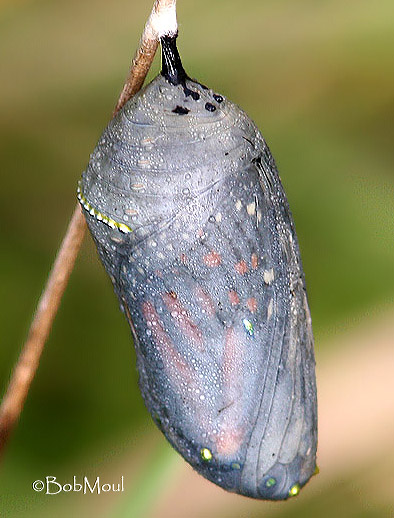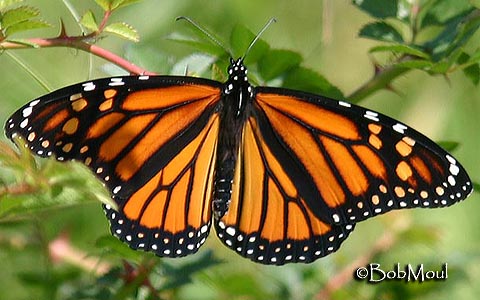Life Cycle of Butterflies and Moths
As advanced insects, butterflies and moths have a "complete" life cycle. This means that there are four separate stages, each of which looks completely different and serves a different purpose in the life of the insect.
This is the life cycle of the Monarch (Danaus plexippus).
![]() The egg is a tiny, round, oval, or cylindrical object, usually with fine ribs and other microscopic structures. The female attaches the egg to leaves, stems, or other objects, usually on or near the intended caterpillar food. (Note: photograph is a Snowberry Clearwing egg.)
The egg is a tiny, round, oval, or cylindrical object, usually with fine ribs and other microscopic structures. The female attaches the egg to leaves, stems, or other objects, usually on or near the intended caterpillar food. (Note: photograph is a Snowberry Clearwing egg.)
 The caterpillar (or larva) is the long, worm-like stage of the butterfly or moth. It often has an interesting pattern of stripes or patches, and it may have spine-like hairs. It is the feeding and growth stage. As it grows, it sheds its skin four or more times so as to enclose its rapidly growing body.
The caterpillar (or larva) is the long, worm-like stage of the butterfly or moth. It often has an interesting pattern of stripes or patches, and it may have spine-like hairs. It is the feeding and growth stage. As it grows, it sheds its skin four or more times so as to enclose its rapidly growing body.
 The chrysalis (or pupa) is the transformation stage within which the caterpillar tissues are broken down and the adult insect's structures are formed. The chrysalis of most species is brown or green and blends into the background. Many species overwinter in this stage.
The chrysalis (or pupa) is the transformation stage within which the caterpillar tissues are broken down and the adult insect's structures are formed. The chrysalis of most species is brown or green and blends into the background. Many species overwinter in this stage.
 The adult (or imago) is colorful butterfly or moth usually seen. It is the reproductive and mobile stage for the species. The adults undergo courtship, mating, and egg-laying. The adult butterfly or moth is also the stage that migrates or colonizes new habitats. The butterfly pictured here is a Monarch, which is fairly large in size. The Monarch's wingspan is 3 3/8 - 4 7/8 inches (8.6 - 12.4 cm).
The adult (or imago) is colorful butterfly or moth usually seen. It is the reproductive and mobile stage for the species. The adults undergo courtship, mating, and egg-laying. The adult butterfly or moth is also the stage that migrates or colonizes new habitats. The butterfly pictured here is a Monarch, which is fairly large in size. The Monarch's wingspan is 3 3/8 - 4 7/8 inches (8.6 - 12.4 cm).
Adult Anatomy
![]()
Page text © Paul Opler
Do you have a question about the life cycle?
Visit our Frequently Asked Questions about the butterfly and moth life cycle and find an answer.
